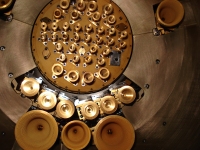Test Chamber Fit Check for the Planck Spacecraft
30 May 2008
Preparations for the upcoming thermal balance / thermal vacuum (TBTV) test of the Planck spacecraft are well under way at the test facilities of Centre Spatial de Liège. On Monday 19 May, the Planck spacecraft was placed inside the FOCAL-5 test chamber for a fit check.The TBTV test campaign will be performed with the FOCAL-5 test chamber. It is used to simulate the cold vacuum conditions of space. The objective of the thermal balance tests is to demonstrate the achieved temperatures of the spacecraft after fine balancing of the temperatures of the individual spacecraft units. The objective of the thermal vacuum tests is to demonstrate that the spacecraft is working nominally when the temperatures of its units are at qualification, acceptance or operational limits.
During the tests, the Planck spacecraft will be surrounded by the eight-sided tubular thermal tent inside the test chamber. The design of the thermal tent, and of the cryo optical shield, allow for cryogenic temperatures - down to the operational temperatures of the detectors - to be reached at the focal plane of the telescope.
 |
 |
 |
|
Figure 1-3: Transfer of the Planck spacecraft from its multi-purpose trolley to the FOCAL-5 test chamber by means of an overhead crane, for the chamber fit check, 19 May 2008. | ||
These images show the spacecraft as it was transferred from its ground support equipment (the multi-purpose trolley) into the FOCAL-5 test chamber on 19 May. The thermal tent was then carefully rolled into the chamber around the spacecraft.
 |
 |
 |
|
Figure 4-6: Placing of the Planck spacecraft inside the FOCAL-5 test chamber, followed by the thermal tent, 19 May 2008. | ||
After the successful fit check, the thermal tent and the Planck spacecraft were removed again from the test chamber. Several other tests, including the system operational validation test (SOVT-1), will be performed prior to the start of the TBTV tests.
The SOVT-1 is the full validation at system level of the complete mission operation chains. It demonstrates that telemetry is received correctly and distributed and archived to the science teams. This test will be managed by the Mission Operations Centre at ESOC in Darmstadt.
The images below, taken on 18 May, show the test configuration of the focal plane unit (FPU) box in close-up, with the feedhorns of the LFI and HFI instruments. In the spacecraft pictures above, the box is hidden from view as the orange telescope cover is in place - see Figure 4. During the TBTV test campaign the performance of the FPU at cryogenic temperatures, down to the operational temperatures of the detectors (of a tenth of a degree above absolute zero) will be demonstrated.
 |
 |
|
Figure 7-8: Close-up of the FPU box configuration for the TBTV test campaign, 18 May 2008. | |

